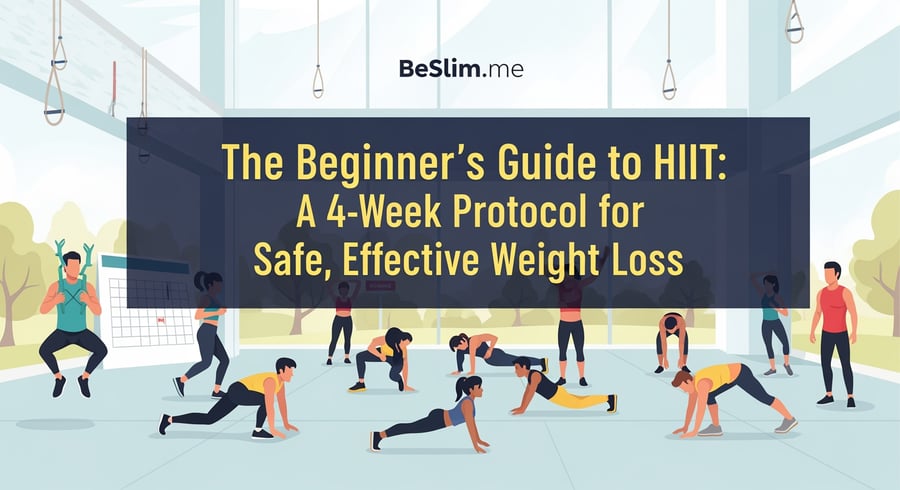Hey there, fitness warriors! I'm Master Kim, your Certified Personal Trainer (CPT) and Biomechanics Specialist at BeSlim.me. If you're new to the world of workouts and dreaming of shedding those extra pounds without risking injury, you've landed in the right spot. High-Intensity Interval Training (HIIT) might sound intimidating, but for beginners, it's all about smart, controlled bursts of effort that rev up your metabolism and torch fat safely. This guide is tailored for you—whether you're working out at home with zero equipment or hitting a basic gym setup. We'll focus on low-impact moves to protect your joints, build confidence, and deliver real results.
In this 4-week protocol, you'll learn the basics of beginner HIIT, why it works for weight loss, and how to execute it with precision. Remember, consistency is key, but safety is non-negotiable. Let's dive in and transform that energy into action—you've got this!
Why Choose Beginner HIIT for Weight Loss?
HIIT isn't just a buzzword; it's a proven method to boost fat loss efficiently. For beginners, we modify it to include short, intense intervals followed by ample recovery, making it accessible and sustainable. Unlike steady-state cardio, HIIT spikes your heart rate quickly, leading to greater calorie burn during and after the workout (hello, afterburn effect!). This guide emphasizes bodyweight exercises to minimize joint stress, helping you build a foundation without overwhelm.
Over the next four weeks, you'll follow a structured routine that progresses gently, incorporating rest days and modifications. Expect to feel more energized, see improved endurance, and notice changes in your body composition. Pair this with a balanced diet for optimal results—think whole foods and hydration to fuel your sessions.
The Science Behind Beginner HIIT Workout and Metabolism
Let's geek out on the science for a moment—because understanding the "why" will keep you motivated! Beginner HIIT revolves around alternating high-effort bursts with low-intensity recovery periods. This structure triggers several physiological responses that supercharge your metabolism and promote fat loss.
First, HIIT enhances your body's ability to burn fat by improving mitochondrial function in your muscles. Mitochondria are like tiny power plants that convert food into energy, and HIIT training increases their efficiency, leading to a higher basal metabolic rate (BMR). This means you burn more calories even at rest. For instance, research on HIIT's impact on fat oxidation shows that even short sessions can elevate fat-burning enzymes, making it ideal for weight loss without long workouts.
Second, the interval nature of HIIT creates an "afterburn" effect, scientifically known as excess post-exercise oxygen consumption (EPOC). After a session, your body works overtime to restore oxygen levels, repair tissues, and clear metabolic byproducts, which can keep your metabolism elevated for hours. This is especially beneficial for beginners, as it maximizes results from shorter workouts. According to Mayo Clinic's overview of HIIT benefits for metabolism, this can lead to significant improvements in insulin sensitivity and cardiovascular health, reducing the risk of metabolic disorders.
Finally, from a biomechanics perspective, beginner HIIT builds muscle endurance without heavy loads, which supports long-term fat loss. Resistance elements in HIIT (like bodyweight squats) stimulate muscle protein synthesis, increasing lean mass that further boosts BMR. A study from the NIH on exercise and metabolic rate highlights how interval training can increase daily energy expenditure by 5-15%, aiding sustainable weight loss. In essence, beginner HIIT isn't just about sweating—it's a metabolic game-changer that helps you lose weight efficiently while preserving muscle.
Safety First: Essential Guidelines for Beginners
Before we jump into the routine, let's prioritize your well-being. As a biomechanics specialist, I can't stress enough: proper form prevents injuries and maximizes benefits. If you have any pre-existing conditions like joint issues or heart concerns, consult a doctor before starting. Always warm up with 5 minutes of light marching or arm circles, and cool down with stretching.
Mandatory Safety Warnings and Form Instructions
- Listen to Your Body: Stop immediately if you feel sharp pain, dizziness, or shortness of breath. HIIT is intense—start slow and build up.
- Joint Protection: Keep movements low-impact; avoid jumping if you have knee or back issues. Modify by stepping instead of hopping.
- Core Engagement: Always engage your core by drawing your navel toward your spine to protect your lower back.
- Breathing Technique: Inhale during the easier phase, exhale on effort. Never hold your breath.
- Posture Check: Maintain a neutral spine—imagine a string pulling the top of your head upward. Shoulders relaxed, not hunched.
- Hydration and Rest: Drink water before, during, and after. Include at least 1-2 rest days per week to recover.
- Equipment Note: No gear needed, but use a mat for floor exercises to cushion joints. If progressing to weights, start light (e.g., 5-10 lbs).
These cues are your foundation—nail them, and you'll train safely and effectively.
Your 4-Week Beginner HIIT Protocol
This protocol is designed as a 4-week program, with workouts 3-4 times per week. Each session is a 30-minute routine: 5-minute warm-up, 20 minutes of HIIT circuits, and 5-minute cool-down. The structure follows a classic HIIT format: 20-30 seconds of high effort followed by 40-60 seconds of recovery (e.g., marching in place). Complete the circuit 2-3 times.
Focus on quality over speed. As a beginner, aim for controlled movements to build strength and confidence. Track your progress in a journal—note how you feel and any improvements in endurance.
30-Minute Workout Routine
Here's your core routine with 6 beginner-friendly exercises. All are bodyweight-based, suitable for home or gym. Perform them in a circuit: Do one set of each, then repeat. High-effort intervals should feel challenging (about 7-8 out of 10 effort), but recoverable.
Exercise Name: Marching in Place with High Knees
- Sets x Reps/Time: 3 sets of 20 seconds high effort / 40 seconds recovery
- One Key Form Cue/Technical Focus: Lift knees to hip height without leaning back; keep core tight to maintain balance.
- Difficulty Level: Beginner
Exercise Name: Bodyweight Squats
- Sets x Reps/Time: 3 sets of 10-12 reps (or 20 seconds effort)
- One Key Form Cue/Technical Focus: Feet shoulder-width apart, lower as if sitting into a chair, knees tracking over toes—don't let them cave in.
- Difficulty Level: Beginner
Exercise Name: Wall Push-Ups
- Sets x Reps/Time: 3 sets of 8-10 reps (or 20 seconds effort)
- One Key Form Cue/Technical Focus: Hands at shoulder height on the wall, body in a straight line; lower chest toward wall by bending elbows, not arching back.
- Difficulty Level: Beginner
Exercise Name: Standing Alternating Toe Touches
- Sets x Reps/Time: 3 sets of 20 seconds high effort / 40 seconds recovery
- One Key Form Cue/Technical Focus: Reach opposite hand to toe while keeping a slight bend in the standing knee; avoid rounding your back.
- Difficulty Level: Beginner
Exercise Name: Seated Leg Lifts
- Sets x Reps/Time: 3 sets of 10 reps per leg (or 20 seconds effort)
- One Key Form Cue/Technical Focus: Sit on the edge of a chair, lift one leg straight out while engaging abs; keep back straight and avoid slouching.
- Difficulty Level: Beginner
Exercise Name: Arm Circles with March
- Sets x Reps/Time: 3 sets of 20 seconds high effort / 40 seconds recovery
- One Key Form Cue/Technical Focus: Circle arms forward in big loops while marching; keep shoulders down and core engaged for stability.
- Difficulty Level: Beginner
These exercises target full-body engagement, promoting fat loss through compound movements that elevate heart rate safely.
Progression Plan: Advancing Over 4-8 Weeks
Progression is key to avoiding plateaus and building resilience. Here's how to evolve this routine over 4-8 weeks, keeping it beginner-focused with gradual increases.
Weeks 1-2: Foundation Building – Stick to the base routine with 20-second efforts and 60-second recoveries. Focus on form mastery. Do 3 sessions per week, with 2 circuits per workout. Goal: Build confidence and consistency.
Weeks 3-4: Intensity Ramp-Up – Shorten recoveries to 40 seconds and extend efforts to 25-30 seconds. Add a third circuit if comfortable. Introduce minor modifications, like holding light dumbbells (2-5 lbs) for squats. Aim for 4 sessions per week. Track improvements in how many reps you complete without fatigue.
Weeks 5-8: Sustained Progress – Increase to 30-second efforts with 30-second recoveries. Incorporate one intermediate variation per session, such as knee push-ups instead of wall push-ups. If ready, extend sessions to 35 minutes by adding a cool-down stretch. Monitor for signs of overtraining—rest if needed. By week 8, you should notice enhanced endurance and visible fat loss.
Remember, progress at your pace. If something feels off, regress to the previous level. Consistency beats perfection!
Additional Tips for Success and Long-Term Fat Loss
To make this protocol a lifestyle, integrate these actionable takeaways:
Nutrition Synergy: Fuel with protein-rich meals post-workout to support muscle repair and BMR. Aim for 1,500-2,000 calories daily, depending on your needs, with a focus on veggies, lean proteins, and healthy fats.
Tracking Progress: Weigh yourself weekly, but also measure waist circumference and note energy levels. Apps like MyFitnessPal can help log workouts.
Common Mistakes to Avoid: Don't skip warm-ups—they reduce injury risk by 30% according to fitness research. Stay hydrated to maintain performance.
Motivation Boost: Set mini-goals, like completing all sessions in a week, and reward yourself. Join online communities for accountability.
By week 4, many beginners report losing 2-5 pounds, but results vary—focus on how you feel stronger and more vibrant. HIIT's magic lies in its efficiency; just 30 minutes can yield benefits comparable to longer cardio sessions.
In closing, as Master Kim, I'm thrilled to guide you on this journey. Embrace the challenge, prioritize safety, and watch your body transform. You've got the power—now go crush those intervals!
References
Medical Disclaimer
The content on this website is for informational and educational purposes only. It is not intended as medical advice and should not be relied upon as a substitute for consultations with qualified healthcare professionals who are familiar with your individual medical needs. Always seek the advice of your physician or other qualified healthcare provider with any questions you may have regarding a medical condition. Never disregard professional medical advice or delay in seeking it because of something you have read on this website.





Comments (0)
No comments yet. Be the first to comment!